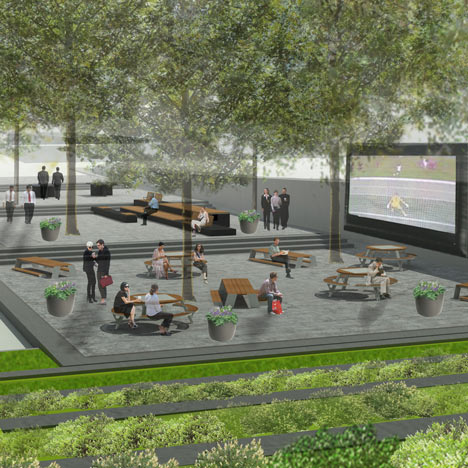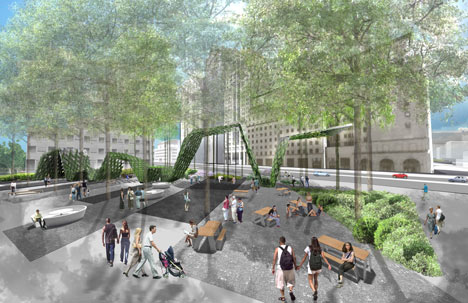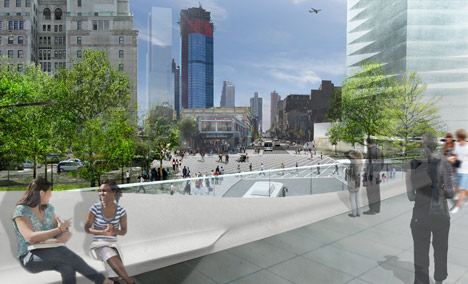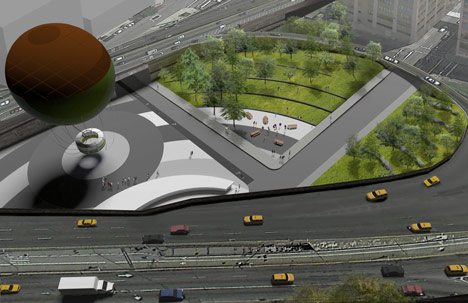
New York "can overtake Silicon Valley" as tech hub
News: urban improvements such as cycle paths, parks and public transport could transform Brooklyn and help turn New York City into the USA's leading location for technology firms, according to plans unveiled this week.
"New York City, now the second leading tech hub in the nation, can overtake Silicon Valley in the top spot," said the Brooklyn Tech Triangle coalition, as it unveiled a strategic plan to transform former industrial areas of the borough into a high-tech hub.
The coalition wants to transform the area between Downtown Brooklyn, DUMBO and the Brooklyn Navy Yard by creating new office spaces, improving transportation and pedestrian access, and adding cycle paths, footbridges and more green areas.
New York architects WXY Architecture + Urban Design drew up the plan. WXY founding principal Claire Weisz said: "The plan will help make the Tech Triangle a great place for tech firms to be - encouraging cafes and new outdoor spaces, better cycle routes, and new spaces for startups."
"The city has a golden opportunity in the Brooklyn Tech Triangle," said Tucker Reed, president of Downtown Brooklyn Partnership, one of the organisations backing the plan. "This new strategic plan lays out specific ideas which will make the Brooklyn Tech Triangle the most attractive place for tech to set up shop and stay.”
The initiative comes at a time when New York's technology sector is experiencing a surge in activity, with companies including Facebook opening new offices in the city and Cornell University partnering with the city to build a large tech campus on Roosevelt Island in the East River.
This boom is part of what some commentators see as a broader shift that is seeing tech firms move away from the sprawling, suburban culture of Silicon Valley to more compact, urban locations such as New York and London.
In an article in The Wall Street Journal last year, urban studies theorist Richard Florida claimed that technology firms are moving to cities to be closer to designers and end users, as well as the vibrant urban culture that cities offer. Engineers today are "less interested in owning cars and big houses," preferring to live "somewhere which has lots of bars and lots of places you can eat," Florida wrote.

Brooklyn is already home to many innovation-based firms, including online marketplace Etsy and 3D printer brand MakerBot, but the coalition believes that limited spaces for new businesses could stifle growth.
In response, WXY have devised a scheme to create a "Special Innovation District" by incentivising the redevelopment of industrial buildings.
WXY's managing principal Adam Lubinsky said: "Brooklyn’s synergy between living and working in a creative environment will benefit from initiatives like the Special Innovation District, bolstered by relocation incentives tweaked for startups and incentives for landowners to upgrade their buildings."
The architects also propose creating a hot-air balloon-inspired observation platform, a cafe and a "tech terrace" with a huge digital screen. Brooklyn Tech Triangle claims that the proposals could act as a blueprint for other innovation districts in New York, helping the city to overcome Silicon Valley as the most popular location in the country for technology firms.

Research conducted by the coalition found that more than 9,600 people were employed in 560 tech companies in Brooklyn in 2012, which generated $3.1 billion. This figure is set to almost double by 2015.
The strategy has been backed by the public, private and academic sectors and now requires support from the government and real estate companies so over 370,000 square metres of space can be adapted to house technology and creative companies.

Several other cities have recently launched initiatives aimed at challenging Silicon Valley's dominance of the technology industry, including the Tech City district of East London, which is home to a shared workplace operated by Google and is the site of a proposal for an office building covered in digital advertisements by architects 00:/.
See all stories about technology companies »
See all stories about New York »
Here are some more details about the plan:
Brooklyn Tech Triangle coalition reveals strategy to surpass Silicon Valley
Plan details proposals on workforce development, real estate incentives and zoning, transportation linkages and public space creation
New York City, now the second leading tech hub in the nation, can overtake Silicon Valley in the top spot, according to a strategic plan released today by the Brooklyn Tech Triangle coalition. The strategy – which has broad public-, private- and academic-sector backing – calls for enhancing workforce development, increasing the availability of affordable real estate, and improving transportation and public environs. It also points out that failure to take action now could jeopardize the City’s economic vitality. Focused on the areas between Downtown Brooklyn, DUMBO and the Brooklyn Navy Yard, the plan is widely viewed as the model for creating innovation districts throughout NYC.
The Brooklyn Tech Triangle is a magnet for innovation-based entrepreneurs and has emerged as the City’s largest cluster of tech activity outside of Manhattan. It is projected that in two years the area will support 18,000 tech-related jobs and 43,000 indirect jobs. However, a lack of appropriate commercial and light industrial space to support the innovation economy and an adequately trained workforce, among other factors, threaten to stifle this growth, according to the strategic plan authored by a team led by WXY Architecture + Urban Design.
The Brooklyn Tech Triangle coalition – led by the Downtown Brooklyn Partnership, DUMBO Improvement District and the Brooklyn Navy Yard Development Corporation – seeks to address these challenges. If the Brooklyn Tech Triangle plan is fully implemented with support from government, the real estate community, tech firms and academic institutions, up to 4 million square feet of space in the Tech Triangle would be occupied by tech and creative businesses in 2015.
Funding and other support for the Brooklyn Tech Triangle initiative has come from Empire State Development Corporation, Office of New York City Deputy Mayor for Economic Development, New York City Department of Small Business Services, New York City Council and Speaker Christine Quinn, Borough President Marty Markowitz, New York University, Polytechnic Institute of New York University (NYU-Poly), NYU’s Center for Urban Science and Progress (CUSP) and the Brooklyn Community Foundation.
"The City has a golden opportunity in the Brooklyn Tech Triangle," said Tucker Reed, president of the Downtown Brooklyn Partnership. "To seize it, we need to create space for tech growth and tap into our talent pools of local residents and students enrolled in the area’s 12 universities. This new strategic plan lays out specific ideas which will make the Brooklyn Tech Triangle the most attractive place for tech to set up shop and stay.”
The Brooklyn Tech Triangle coalition conducted an economic impact study of the tech sector in Brooklyn in 2012 that found there are more than 520 tech companies employing over 9,600 people, generating $3.1 billion of economic output and is poised to nearly double by 2015, requiring an additional 2.2 million square feet of office space. Following the study, the coalition formed a task force comprised of local tech firms, entrepreneurs, government representatives, real estate firms, area residents and civic leaders and educators to develop a strategic plan to capitalize on this upward trend.
“Innovative companies want to grow and create great jobs here. We have to unlock the potential of our real estate - the buildings that were home to New York's industrial boom once before - to make sure they can do just that. We also have to unlock the potential of our local workforce to make sure they can give those jobs to New Yorkers for years to come,” said Alexandria Sica, executive director of the DUMBO Improvement District. “The Brooklyn Tech Triangle coalition looks forward to working with residents, companies and elected leaders to turn these ideas into reality.”
“This is an activation plan for the 21st century and a blueprint for ensuring that surrounding communities can benefit from economic opportunities emerging in the Tech Triangle, and that innovation economy businesses find space to grow,” said Andrew Kimball, president/CEO of Brooklyn Navy Yard Development Corp.